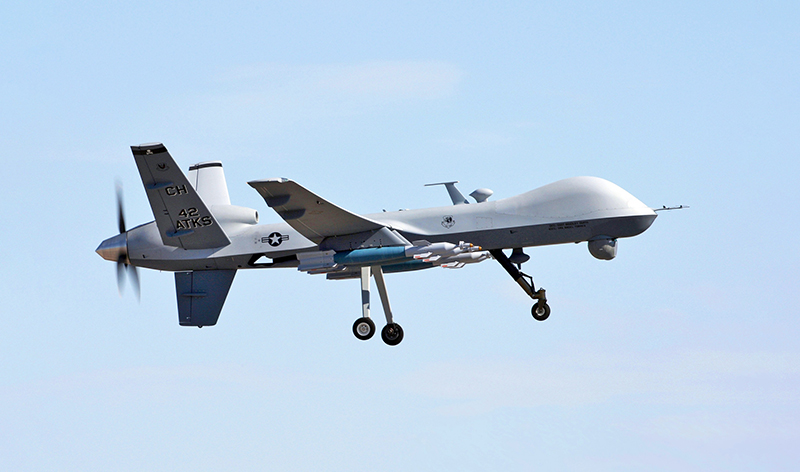Perpetual War and Permanent Peace
Human nature being what it is, what’s the likelihood of a dramatic shift from globalized arms production to disarmament and universal peace?
The literature on war is vast, but there are some basic truths when it comes to understanding its causes. One of those truths is that human beings are at the core. As philosopher David Livingstone Smith puts it, “war can be approached from many angles . . . , but there is one dimension that underpins them all: the bedrock of human nature. To understand war, we must understand ourselves” (The Most Dangerous Animal).
One way to begin to understand ourselves and our propensity for conflict is to examine our willingness to manufacture and use weapons of destruction. The growing scope of human acquiescence in the almost universal war project is clear (very few countries are permanently neutral or have no military). Since the beginning of the 21st century, global military expenditure has doubled to more than US$2.1 trillion, or $268 for every person on earth.
According to the 2022 Stockholm International Peace Research Institute (SIPRI) report, the United States led the way with 38 percent of the world total, or US$801 billion. A distant second was China (293), followed by India (76.6), the United Kingdom (68.4) and Russia (65.9). Europe’s collective expenditure rose to US$418 billion. While most of the increase was in conventional weapons, SIPRI noted more gravely, “The nine states that possess nuclear weapons were all engaged in upgrading their nuclear arsenals.”
Using SIPRI statistics and global agricultural research data, science writer Julian Cribb contextualizes these levels of military expenditure effectively when he writes that humanity might be defined today as “a species which spends 34 times more on better ways to kill itself than it does on better ways to feed itself.”
“. . . The essential and unchanged truth of war is the interplay of human beings. However, the character of war, or the means with which humans fight wars, has constantly evolved.”
Of course, it’s not a simple one-to-one equation. Some wealthier nations spend a greater percentage of their gross domestic product (GDP) on military budgets than others. For example, though the United States spends far more than either Saudi Arabia or Russia, the Saudi and Russian shares of GDP—6.6 and 4.1 percent respectively—are greater than that of the United States at 3.5 percent. Further, some nations, by dint of recent history, chose for many years to limit military expenditures (Germany) or renounce war (Japan), while many poorer nations simply cannot afford advanced military outlays. Some nations are protected by others; for example, Greenland by Denmark, and the neutral Vatican City by Switzerland (though officially also neutral). Thus there is great unevenness in the picture. But the larger point is surely that most nations learn war and seek some level of military preparedness.
Here the global arms trade comes into the picture. For 2017–21, SIPRI identified 60 nations, large and small, as manufacturers and exporters of major arms. Some have self-sufficiency in mind, while others are limited to continuous dependency. In the same period, 163 nations imported arms. The top five (India, Saudi Arabia, Egypt, Australia and China) account for 38 percent of total arms imports.
In thinking about whether there can ever be an end to war, it’s worth considering how today’s global armaments complex came about. The defense industry has not always been front and center, having emerged only after World War II. While industrialized armaments production existed on a small scale prior to and during World War I, it was the Nazi rise to power and the global Allied response that gave weapons manufacturers their entrée. The ensuing Cold War between East and West, when US and Soviet superpowers faced off, meant the expansion of arms production for decades to come.
Continual widespread war during the next half century gave the armaments industry the impetus to globalize and fostered rapid technological development. This happened not only in the United States, the Soviet Union (later the Russian Federation) and Western Europe but also in China, India, Israel, South Africa and Brazil.
New possibilities for offense and defense have emerged in the past 30 years. Several specific technologies—the result of the fourth industrial revolution—are likely to have a great impact on military affairs in this century. According to military strategist Mick Ryan, these include “artificial intelligence, robotics, quantum technology, biotechnology, energy weapons, hypersonics, space technology, and additive manufacturing [3D printing].”
Similarly, counter-insurgency warfare specialist Thomas Hammes notes that “advances in nanotechnology, drones, task-specific artificial intelligence and space will have direct impact. . . . Over the next ten to twenty years, their convergence will drive deglobalization and major shifts in the character of war.”
“Unmanned systems will saturate the battlespace from space to under the oceans. Sensors will be ubiquitous. . . . Hypersonic craft will blur the distinction between the atmosphere and space. . . . Biotechnology will erode the distinction between human and machine.”
It’s obvious that none of this development would be possible without the human factor. And though technological development is central to war’s changing nature, it is the human element that will always dominate. Ryan writes, “Despite massive and ongoing advances in technology, it will be the combination of new ideas, new institutions, and well-trained and ‑educated people that will prove decisive for military organizations in twenty-first-century competition and war.” More generally, the human element underlies the seeming inevitability of war: “The destructiveness, the justice or injustice, the relative mercilessness of any war never depended on the weapons available to the warriors. Rather, it depended on what was on the warriors’ minds” (Angelo Codevilla and Paul Seabury, War: Ends and Means).
A Complex Issue
In a world that yearns for disarmament and peace, warfare will thus continue to be a globalized problem. As we see, the defense industry is a key element in the equation, answering the demands of military establishments and governments that need jobs creation and the growth of defense-related exports to further domestic prosperity.
This raises fundamental moral questions, though not for the first time. Following World War II, American general Omar Bradley summarized the moral deficit that had emerged after that conflict. In 1948 he said, “The world has achieved brilliance without wisdom, power without conscience. Ours is a world of nuclear giants and ethical infants. We know more about war than we know about peace, more about killing than we know about living.”
Despite Bradley’s perceptive analysis, a wartime colleague, US president Dwight D. Eisenhower (1953–61), oversaw the phenomenal postwar growth and development of the American military-industrial complex. Yet when it came time to step down from office, he, too, made a speech in which he warned about the dangers inherent in the relentless pursuit of supremacy by military-industrial means: “In the councils of government, we must guard against the acquisition of unwarranted influence, whether sought or unsought, by the military-industrial complex. The potential for the disastrous rise of misplaced power exists and will persist.”
Today the military-industrial complex is far more powerful and influential than Eisenhower could have imagined. According to the US State Department’s 2021 report, “World Military Expenditures and Arms Transfers,” “about 79 percent of world arms trade by value appears to have been supplied by the United States, about 10 percent by the European Union, about 5 percent by Russia, and less than 2 percent by China.”
The reason usually given for this disparity is that the United States has obligations worldwide, whereas other nations do not. And while there have been ups and downs in spending and development over the past several decades, the future of the industry now seems to depend on five factors. Military and defense analyst Richard Bitzinger notes that they are the hierarchical nature of the global arms industry, defense spending, the global arms market, the globalization of armaments production (though according to Hammes, production will deglobalize over the next few years to become more regional), and the emerging information technologies–based revolution in military affairs.
Let’s look at them in more detail and assess the likelihood of a dramatic shift from involvement in globalized arms production to disarmament and universal peace.

Key Factors
Just a few primary actors affect the arms industry at the global level. Currently the top 10 most influential players, with the largest output and the most money to spend on research and development, account for almost 92 percent of market share. They are the United States, Russia, France, China, Germany, Italy, the United Kingdom, South Korea, Spain and Israel. Others in the second, third or fourth tiers of the arms hierarchy may adapt and modify or copy and reproduce what these leading nations do. They simply cannot compete. They must choose between the high cost of dependency and being left behind.
Because of the depth of commitment to defense industries in first-tier countries, it seems unlikely that they will become less viable. It’s important to note the difficulty of uncoupling the arms industry from national prosperity and employment in such countries. According to SIPRI, the “strong relationship between arms producers and governments and the industry’s perceived importance to national security . . . shield it from the immediate impact of severe economic downturns. This status is reflected in the continued high levels of arms sales, high profits, large backlogs and strong cash flows generated by arms production.” If this is the case for those who produce most of the world’s armaments, significant reduction in such production is unlikely.
The second factor is the defense budgets of these and other nations, which are themselves affected by a variety of factors. They do not always increase. Major shifts in the geopolitical landscape, such as the collapse of the Soviet Union and the subsequent impact on those countries in its orbit, affect production and sales.
The peace dividend associated with the end of the Cold War meant that many were laid off in defense-related industries, and arms producers consolidated or merged. But since the turn of the 21st century, spending has increased again as long-planned projects have come online, and the wars in Iraq, Afghanistan and various East and South Asian nations have boosted spending levels. According to SIPRI, China’s estimated military spending of US$293 billion was a 4.7 percent increase from 2020. Russia’s spending grew for the third consecutive year in 2021, up by 2.9 per cent at US$65.9 billion, probably reflecting the increasing cost of war with Ukraine. Because surprise is a continuing element in the outbreak of war, expectation that demand for armaments will somehow disappear is naive.
Third is that by no means all of the armaments produced by any nation are intended for domestic defensive purposes. In the global arms market, weapons made by several of the leading manufacturers are primarily for export. As noted above, what was produced in 2021 by companies in the top 10 armaments-producing countries accounted for the majority of the world’s arms exports. It’s clear that the arms bazaar is so intertwined, internationalized and interdependent that untangling it and making significant changes would be extraordinarily difficult.
A fourth and related factor is the move away from single-nation arms producers to transnational companies. While producers may scale back on globalization and turn to more regionally based relationships in the years ahead, armaments will continue to be a dominant aspect of world trade. It is not simply a matter of international investment but of joint ventures and cross-border mergers and acquisitions. This creates vulnerabilities in the event of serious conflicts. Nations cannot risk being held hostage by critical production facilities outside their borders. This is particularly true of the specialized parts needed for advanced technologies. In producer nations, the globalization of arms production also creates vulnerability to rogue elements that may seek access to advanced technologies. Yet armaments are so critically needed by host country and producer alike that it’s unlikely they will scale back operations.
The fifth factor that inevitably affects the global arms industry is the continuing demand for improved weapons and systems. According to Bitzinger, the revolution in military affairs is “nothing less than a paradigm shift in the character and conduct of warfare, and is thus seen as a process of discontinuous and disruptive (as opposed to evolutionary and sustaining) change.” What he describes is network-centric warfare; that is to say, war fought with the aid of linked computers, sensors, microelectronics, miniaturization and related technology.
“The competition among warfighters for more bits and bytes will be fiercer than the competition for bullets and bombs.”
This shift will demand responsiveness on the part of arms producers, and there’s no reason to believe they won’t comply. Witness the growth in the development and deployment of drone aircraft or unmanned aerial vehicles for surveillance, reconnaissance, communications and strike. The introduction of the Predator, Reaper and Global Hawk drones into the Iraq/Afghanistan/Pakistan theater changed the face of conflict. Often launched from distant air bases and guided by operators in faraway facilities, these weapons are really complete systems. There are now thousands of such drones in operation in aerial, ground and marine applications.
Adding to the complexity, danger and destructive power is the introduction of drone swarms and autonomous weapons that seek and destroy. Because much of the underlying technology is in the public domain, the intersecting of 3D printing with AI and drone technology means that for $2,500, nonmilitary actors can get their hands on a very dangerous weapon. Hammes observes, “The convergence of emerging technologies is creating a new generation of small, smart, and cheap weapons. These weapons will dramatically increase the ability of small states and even nonstate actors to challenge major powers.”
Again, under these circumstances it is unlikely that the arms producers will cease their search for and production of new weapons of war. Several years ago, defense strategist and futurist Peter W. Singer spoke of his growing sense that “we are in the midst of something important, maybe even a revolution in warfare and technology that will literally transform human history.” As we are seeing, that is now reality.

Another View
As an aside to this new thrust in military-industrial thinking, Victor Davis Hanson notes that “even with changing technologies and ideologies, and new prophets of novel strategies and unconventional doctrines, conflict will remain the familiar father of us all—as long as human nature stays constant and unchanging over time and across space and cultures.” His summary statement is that “war is an entirely human enterprise” (The Father of Us All: War and History, Ancient and Modern).
And here is our point of departure in considering the biblical dimensions of this global problem of warfare. War as we know it is indeed an entirely human enterprise. But what is it in the heart of man that causes this perpetual descent into killing off another part of the species?
Sometimes it’s envy. In the first recorded murder in the first book of the Bible, a man kills his innocent brother “because his own deeds were evil and his brother’s righteous” (1 John 3:12). This is the apostle John’s conclusion looking back over human history to that early time. In other words, there is right and wrong behavior toward our fellow man. One commentary says of Cain’s behavior, “It is as if he could not wait to destroy his brother—a natural man’s solution to his own failure.” How often has envy and psychological inferiority played into one nation’s aggression against others?
Another New Testament writer, James the brother of Jesus, asks, “What causes quarrels and what causes fights among you?” His reply defines other aspects of human aggression: “Is it not this, that your passions are at war within you? You desire and do not have, so you murder. You covet and cannot obtain, so you fight and quarrel” (James 4:1–2).
“Human nature is constant, despite radical changes in technology, social systems, and physical landscapes. That bleak reality should remind us that the veneer of civilization is always very thin, while the innate barbarity of humankind is forever very deep.”
It isn’t that we fail to recognize the need for and the benefits of peace. There are many institutes devoted to the promotion of peace. Woodrow Wilson, perhaps the most idealistic of modern American presidents (1913–21), worked tirelessly for the creation of the League of Nations. Though he had well-documented failings, he devoted himself to the cause of peace. He was a highly intelligent, devoutly religious man. But he could not achieve his goal, despite the fact that other well-intentioned world leaders joined him.
Within 20 years after World War I, the entire planet was on the brink of terrible violence again. The war to end all wars was a forlorn hope.
The United Nations inherited its goals from the League. Outside its headquarters in New York stands a sculpture, a 1959 gift from the Soviet Union. On its base the ideal of peace is expressed in the words “We shall beat our swords into plowshares,” taken from the prophetic book of Micah. Sixty years later, there has been little progress toward universal peace. No matter the idealism of human leaders, humanity has not succeeded in overcoming what seems like a death wish.
Does that mean peace can never come? Hanson would say not as long as we have human nature. But what did the prophet mean when he wrote, “They shall beat their swords into plowshares, and their spears into pruning hooks; nation shall not lift up sword against nation, neither shall they learn war anymore” (Micah 4:3)? Is this just senseless idealism? Or was he reflecting a divine imperative? Is it possible that a time is yet ahead for the planet when the end of war will be a reality—when people will simply not learn war?
Jesus of Nazareth came with a clear message of a coming time of universal peace on earth, when human nature would undergo transformation. He spoke of a future time of “regeneration” (Matthew 19:28, New King James Version). The apostle Peter referred to a time of the “restitution of all things” (Acts 3:21, King James Version); and calling on the older prophets, Paul wrote that to focus the mind on “the things of the Spirit . . . is life and peace” (Romans 8:5–6). It was the prophet Jeremiah who had recorded God’s words concerning the answer to human nature’s downside: “I will put my law within them, and I will write it on their hearts” (Jeremiah 31:33). This is the way of transformation for the human heart, and it alone can lead to peace that is from then on willingly self-generated.
Can anything be done in the meantime? Like so many other problems common to humankind, the best place to start is at home, with you and me. The human mind can be individually renewed and made peaceful now. How? In the way that has been known for thousands of years but little practiced. The same prophet that speaks of swords being beaten into tools of peaceful production explains, “He has told you, O man, what is good; and what does the Lord require of you but to do justice, and to love kindness, and to walk humbly with your God?” (Micah 6:8). That same God tells us, “The wisdom from above is first pure, then peaceable, gentle, open to reason, full of mercy and good fruits, impartial and sincere. And a harvest of righteousness is sown in peace by those who make peace” (James 3:17–18).


